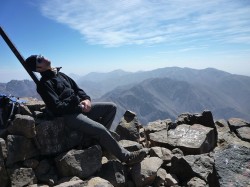
How do I stay? healthy in height is a medical source of information for people who want to spend their holidays at altitudes above 2500 meters. This group mainly consists of hikers and hikers, but also snowboarders, mountain bikers and skiers. In this eBook the problems of the common and often underestimated come mainly altitude sickness to be discussed: how can this disease be prevented, and what to do if one does become highly ill?
More and more people are spending their holidays skiing, snowboarding, mountain biking, hiking or trekking at high altitudes. Mont Blanc (4807 m), other mountains in the Alps (up to more than 4500 m), Mount Kilimanjaro (5896 m), Lhasa (3400 m), base camp Mount Everest (5200 m), Inca-trail Peru (4100 m), they are all destinations that are within reach for the average healthy tourist nowadays. Many travel organisations take you where you want to go, although...
Even in the Alps, about 10-25% of climbers suffer from altitude sickness
Not every attempt to deliver such a performance is successful. From the many experiences that have now been gained with this form of leisure activities, we know, for example, that altitude sickness can already occur above 2500 meters, and in rare cases even from around 2000 meters. You don't even have to go far away for this: in the Alps, around 10-25% of climbers already suffer from altitude sickness at 3000 meters, and this percentage rises to around 50% at 4500 meters. Above 5500 meters, an extreme height for humans, almost everyone will have to deal with at least a slight form of altitude sickness. The number of seriously ill is increasing sharply from that height and not everyone survives. In 1998, around 1500 people climbed the Aconcagua in Chile (6962 m); 150 of them reached the top, but a large number became highly ill and 11 did not survive. With a longer stay at or above 5500 meters, people begin to gradually decline, both physically and mentally. Virtually all cases of life-threatening forms of altitude sickness are the result of wanting to ascend and climb further too quickly, despite symptoms and symptoms suggesting incipient altitude sickness.

The structure of this eBook is as follows:
In Chapter 1 you can read something about the history of the discovery of height (problems) by humans.
In chapter 2 we move on to the main topic of this eBook: altitude sickness. You will learn how your body reacts to a lack of oxygen. In this book, altitude sickness means the three forms that occur: acute altitude sickness, altitude pulmonary oedema, and altitude cerebral oedema.
Chapter 3 informs you about how you can prevent altitude sickness.
If you have not succeeded in this and you have had acute altitude sickness, pulmonary edema or brain edema, then you need to know what you can do to prevent worse. That's what the chapters 4, 5 and 6. In the overview with this introduction you will find all the recommendations summarized.
In chapter 7 you will find a tool to register and follow your condition while climbing.
Chapter 8 then treats a number of smaller, but sometimes very annoying problems that you may encounter in the mountains. An example is the so-called Kumbu Cough, a rare but persistent and annoying form of constant coughing at some people at height. Innocent, but very annoying for yourself and your fellow travelers.
Then there is attention for people with a health problem who still want to go into the mountains. In chapter 9 can they find information.
Chapter 10 Finally, the altitude traveler himself gives the floor. Frequently asked questions are answered briefly by the author.
In this eBook various true stories about problems in the mountains are described. They come from different sources and have been adapted by the author for the sake of readability and the example function. That is why a specific source reference is missing. The names are of course fictitious.
If you are considering putting on the naughty (mountain) shoes and going hiking, cycling, skiing or climbing above 2500 meters, then read this eBook and take the advice seriously. You run little risk of getting altitude sickness: a nice holiday for you and your traveling companions is in the offing.
The handy eBook 'How do I stay healthy?' Costs only € 9.5
and can be ordered via this link.
